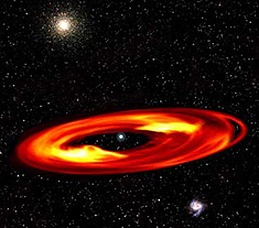The stellar department studies the Universe over a wide range of electromagnetic radiation from stars in the Solar neighbourhood, stellar clusters to galaxies and quasars in the distant universe.
The department is organised into three working groups
|
 |
Physics of hot stars The main focus of the group is the study of hot stars, for example B stars. These are massive and very luminous stars and some show the presence of a stellar disk. The origin and the physical properties of these disks are poorly understood. Research programs of these stars include spectroscopic analyses and numerical modeling of stellar atmospheres and winds. The spectroscopic data are obtained with the 2m telescope at Ondřejov and with telescopes at other observatories. Since 2004, we have expanded our research to hot subluminous stars, including white dwarfs and hot subdwarfs, with strong emphasis on detailed modeling of optical and ultraviolet spectroscopy. The spectroscopic data are obtained at observatories in Chile and United States, as well as with space-borne telescopes. Since 2007, the group is participating in the ESA satellite project Gaia, which starting in 2012 and for a duration of about 5 years will systematically measure accurate positions, luminosities and radial velocities of stars brighter than 20th magnitude.
Head: Jiří Kubát |
|
 |
Operation and development of the 2-m telescope Head: Miroslav Šlechta |
|
 |
High Energy Astrophysics This group’s research interests are in the studies of galactic and extra-galactic high energy sources that emit in the optical, X-ray and gamma-ray spectral regions. Objects that are studied are various types of X-ray binaries, gamma-ray bursts and their optical afterglow, AGNs (for example blazars). This group participates in ESA space projects INTEGRAL, Gaia and XEUS, and collaborates with NASA on the Constellation X project. The group has developed and operates robotic telescopes (BART, D50, BOOTES) that are capable of responding to data obtained from satellites, in particular obtaining optical data following gamma ray burst detections. Other data are obtained from astronomical archives – the time coverage of some objects can be as long as 100 years and such data provide information about the long term behaviour of these objects in the optical range.
Hhead: René Hudec Scientists: René Hudec, Vojtěch Šimon
|
Contact:
stelweb.asu.cas.cz Head: Jiří Kubát
Deputy: Miroslav Šlechta
Secretary: Eva Kortusová
phone: +420 323 620 226
e-mail: eva@sunstel.asu.cas.cz
Address: Fričova 298, 251 65 Ondřejov
